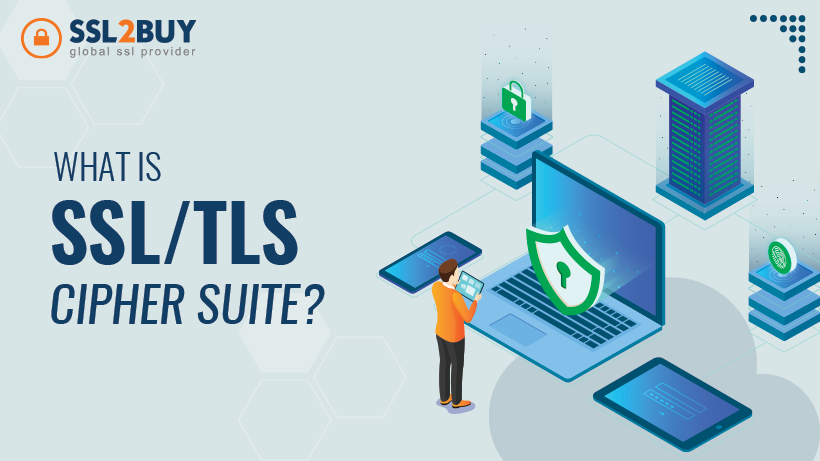
SSL/TLS cipher suite is a collection of cryptographic algorithms that collaborate to enable Secure sockets layer/Transport layer security (SSL/TLS) Protocols. This article explains how a cipher suite provides secure, encrypted online communication.
Let’s dive in!
What is a Cipher Suite?
Cipher suites are set of instructions that enable secure network communications through Transport Layer Security (TLS) or Secure Sockets Layer (SSL). A cipher suite defines the encryption, authentication, and key exchange techniques to ensure secure network connections. A unique set of algorithms work together in each cipher suite to offer a certain degree of security.
The client and the web server must complete SSL handshake to establish HTTPS connection. Each side agrees on a mutual cipher suite throughout the lengthy and intricate handshake process. An HTTPS secure connection is then established using the cipher suite.
The standard representation of a cipher suite is a long string of information that appears random, yet each string segment has significant data. This data string typically consists of the following vital sections:
- Protocol (such as., TLS 1.2 or TLS 1.3).
- Key exchange or agreement algorithm.
- Digital signature (authentication) algorithm.
- Bulk encryption algorithm.
- Message authentication code algorithm (MAC).
As we know, a cipher suite is a collection of instructions used in cryptography that can be used to encrypt and decrypt data. These algorithms can support more than one cipher. The cipher outlines the precise procedures that must be followed for the encryption and decryption.
Each part of a cipher suite has a distinct function of preserving the confidentiality and integrity of data. A cipher suite’s level of security is determined by how these elements are chosen.
The server and your system attempt to use the most robust cipher suite they can support while creating a secure connection. Remember, though, that not every cipher suite provides the same protection. Some are insecure and outdated.
For example, a cipher suite can become open to cyberattacks using outdated or insecure encryption methods.
What is the Purpose of SSL/TLS Cipher Suites, and How Significant Are They?
SSL and TLS require a cipher suite on both ends to offer a secure channel because of the use of encryption algorithms, MACs, and key exchange. They ensure that the data transferred between the parties is secure, verified, and unchangeable.
During a website visit, SSL TLS ciphers protect sensitive/confidential data from being intercepted by unauthorized third parties, such as internet service providers (ISPs).
Cipher suites are implemented via HTTPS, WebDAV, FTPS, POP3, AS2, and IMAP network protocols.
Applications such as web browsers, email applications, virtual private networks (VPNs), and other private and secure communication protocols use cipher suites.
Many communication systems, including digital television, ATMs, and cell phones, rely on advanced ciphers to maintain confidentiality and privacy.
Cipher suites help ensure compatibility because there must be a way to support these combinations.
Examples of Cipher Suites
These are a few examples of cipher suites:
- RSA: A public-key cryptosystem frequently employed in TLS to certify communications between web browsers and websites.
- DHE: A TLS cipher suite key exchange algorithm.
- SHA256: This is a MAC algorithm utilized in TLS cipher suites.
- AES256: TLS cipher suites employ this bulk data encryption method.
The client and server agree on a cipher suite when establishing a TLS or SSL connection. The server selects the most secure and mutually supported cipher suite from the client’s list.
Every cipher suite offers a different degree of security and performance based on the specific communication protocol needs, requirements, and devices involved.
Explore how SSL/TLS Cipher Suites Work. TLS 1.2 and TLS 1.3-Supported Ciphers in the following sections.
How do SSL/TLS Cipher Suites Work?
When the web server and browser communicate information during the connection handshake, they compare their prioritized lists of supported cipher suites to determine compatibility and choose the cipher suite.
The web server will determine which cipher suite is utilized. The combination of the mutually agreed-up cipher suite is:
- Key exchange algorithms: RSA, DH, ECDH, DHE, ECDHE, and PSK.
- Digital signature/authentication algorithms: DSA, ECDSA, or RSA.
- Bulk encryption algorithms: AES, Camellia, or ARIA.
- Message Authentication Code algorithms: SHA-256 and POLY1305.
Ephemeral Elliptic Curve Diffie Hellman (ECDHE) indicates that keys will be exchanged during the handshake (left-to-right direction.) Elliptic Curve Digital Signature Algorithm, or ECDSA, is the name of the employed authentication algorithm. AES is used in Galois Counter Mode with a 128-bit key size in the bulk encryption method known as AES128-GCM. Finally, SHA-256 is the hashing algorithm.
What is the Need for Cipher Suites?
- It is impossible to underestimate the significance of cipher suites. Its confidentiality guarantees that the specified person can only read the data you provide. Without Cipher Suites, private email addresses, passwords, and other sensitive data can be obtained by hackers.
- Robust cipher suites play an increasingly more critical role in an era of growing cyber threats. They serve as the initial defense against online attacks and data breaches. Having the appropriate cipher suite is more important than simply having one.
- Security is available in different suites at different degrees. While some are outdated and weak, others offer a strong defense. Online security must be maintained by comprehending and choosing the best cipher suite.
Ciphers Supported by TLS 1.2
Before explaining some of the different cipher suites that one can find with the TLS protocol, it is good to remember that TLS 1.0 and TLS 1.1 are two TLS protocols that came before TLS 1.2. These versions have fallen out of use for different safety reasons. If TLS 1.2 has TLS 1.3, no more version has followed this one waiting for the coming TLS 1.4. TLS 1.2 and TLS 1.3 are the only two TLS protocols currently in use.
Later on, the protocol supports 37 distinct cipher suites, starting with TLS 1.2. Should this number seem significant, consider that TLS 1.2 has existed for nearly ten years, and numerous other solutions have emerged. Since each cipher suite comprises four distinct algorithms, forty combinations of ciphers exist.
We should use the ephemeral Diffie-Hellman algorithm-equipped cipher suites out of all those provided by TLS 1.2. Thus, the following are the recommended cipher suites:
| TLS_ECDHE_ECDSA_WITH_AES_128_GCM_SHA256 |
| TLS_ECDHE_ECDSA_WITH_AES_256_GCM_SHA384 |
| TLS_ECDHE_ECDSA_WITH_AES_128_CBC_SHA256 |
| TLS_ECDHE_ECDSA_WITH_AES_256_CBC_SHA384 |
| TLS_ECDHE_RSA_WITH_AES_128_GCM_SHA256 |
| TLS_ECDHE_RSA_WITH_AES_256_GCM_SHA384 |
| TLS_ECDHE_RSA_WITH_AES_128_CBC_SHA256 |
| TLS_ECDHE_RSA_WITH_AES_256_CBC_SHA384 |
| TLS_ECDHE_RSA_WITH_AES_128_CBC_SHA256 |
| TLS_ECDHE_RSA_WITH_AES_256_CBC_SHA384 |
| TLS_DHE_RSA_WITH_AES_128_GCM_SHA256 |
| TLS_DHE_RSA_WITH_AES_256_GCM_SHA384 |
| TLS_DHE_RSA_WITH_AES_128_CBC_SHA |
| TLS_DHE_RSA_WITH_AES_256_CBC_SHA |
| TLS_DHE_RSA_WITH_AES_128_CBC_SHA256 |
| TLS_DHE_RSA_WITH_AES_256_CBC_SHA256 |
| TLS_ECDHE_ECDSA_WITH_CHACHA20_POLY1305_SHA256 |
| TLS_ECDHE_ECDSA_WITH_CHACHA20_POLY1305 |
| TLS_ECDHE_RSA_WITH_CHACHA20_POLY1305_SHA256 |
| TLS_ECDHE_RSA_WITH_CHACHA20_POLY1305 |
Ciphers Supported by TLS 1.3
The client knows that the key exchange procedure will employ the key exchange method called ephemeral Diffie Hellman. Hence, initiating the handshake and leaving its portion of the key in the Client Hello message is essential.
The advantage is that both sides can get the session key and start a secure communication line because the TLS 1.3 handshake only requires one round trip. After all, the server transfers all necessary data once. Additionally, a single transfer improves connection speed and security.
The supported cipher suites in TLS 1.3 have now dropped to just five and are the following:
| TLS_AES_256_GCM_SHA384 |
| TLS_CHACHA20_POLY1305_SHA256 |
| TLS_AES_128_GCM_SHA256 |
| TLS_AES_128_CCM_8_SHA256 |
| TLS_AES_128_CCM_SHA256 |
Analyzing the Cipher Suite’s Algorithms
As previously described, a client and a server can support distinct cipher suites depending on their SSL/TLS version.
An illustration of the TLS protocol and the four ciphers that make up this particular TLS 1.2 cipher suite are DHE, RSA, AES [256 strength and CBC mode], and SHA-2.
AES [256 strength and GCM mode] and SHA-2, the two ciphers that make up this particular TLS 1.3 cipher suite, are shown in the figure together with the TLS protocol.
Key Exchange Algorithm
It is necessary to communicate data securely so both parties can use it to generate session keys and establish a secure channel. This is handled during the handshake step via a “key exchange algorithm.”
The SSL handshake begins with the client’s hello. The following is included in the client hello:
- Session ID: Included in the client hello is the encryption key for the session.
- Client cipher suite list: The list of cipher algorithms the client browser supports and transmits to the server is known as the client cipher suite list.
- Random data: To prevent fraudsters from being able to identify the session key, random data is added to the client greeting.
- Compression algorithm: Client Hello also includes a data compression process to expedite the encryption procedure.
The essential exchange technique shields the session ID or encryption key from prying eyes. It is, therefore, an essential component of the cipher suite.
Digital Signature Algorithm
- The recipient verifies the message’s sender identity via the signature algorithm, also known as the authentication algorithm. It is essential for secure communication because it guarantees that correspondence occurs with an authorized server.
- RSA (including PKCS#1 variations) and ECDSA are recommended digital signature methods in TLS 1.3. With TLS 1.2 to TLS 1.3, DSA signatures were deprecated.
- To calculate the same symmetric key for message encryption, the client and server exchange ephemeral, or transient, public keys. They are not the same as the public keys associated with the host certificate. Each time a connection is made, they are created at random.
- To verify to the client that the ephemeral key originated from a trustworthy source, the server hashes the ephemeral public key using the private key. The temporary key is dropped as soon as a secure channel is created. The client can verify the sender’s identity by contrasting the signature and data hashes.
Bulk Encryption Algorithms
- After the key exchange or creation, when both the client and the website server agree, it’s ready to proceed to the primary communication. The bulk encryption techniques are now available.
- Using a single key, a symmetric bulk encryption technique converts the input plaintext into an output ciphertext of a set length. Therefore, the ciphertext’s length will remain constant, independent of the plaintext’s length.
- AES is the encryption standard for bulk data using protocols TLS 1.2 and TLS 1.3. It uses encryption keys of 128 bits, 192 bits, and 256 bits. Larger key sizes increase the security level.
Hash-Based Message Authentication Code (HMAC) Function.
Hash-based MAC (HMAC) is a specific type of message authentication code (MAC) that uses a secret cryptographic key and a cryptographic hash function. HMAC enables the verification of a message’s authenticity and data integrity.
Moreover, it preserves the authenticity and integrity of the handshake. This makes it difficult for attackers to intercept or alter any information during an exchange in the handshake phase.
It achieves this by using a secret key in combination with a hashing algorithm to ensure that no one has changed the data that was supposed to remain the same.
Wrap up!
A cipher suite is a collection of algorithms that enables secure communication between a server and a client. Additionally, it uses a robust encryption method that combines sophisticated hash algorithms for message authentication with authenticated key encryption. Moreover, TLS 1.3 is more secure and faster than TLS 1.2 since it requires fewer handshake round trips, even if each cipher suite has fewer algorithms. Each algorithm cipher suite supported by the client and the server is mutually agreed upon.
Although both protocols are in use, TLS 1.3 will eventually replace TLS 1.2.



